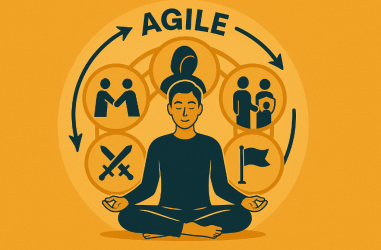The more you drive, the more confident you become and the more you can react to unpredictable situations.

When a crisis breaks out in a project, you have to make a quick decision, and in the meantime everyone around you has doubts and gives good advice or criticizes your approach.
When you do not act in accordance with the expectations of your boss/coworkers.
When after a whole day of meetings someone comes with a trivial problem.
When you see that something could be done more easily and you wonder, “why are you working with people who have such little imagination?”.
When someone tries to show you that you are wrong.
… you get frustrated and often explode. Your patience runs out, and your reaction is often the spark that ignites a conflict that, depending on the context, will start to escalate faster or slower.
You cannot avoid such situations, that’s for sure. However, you can choose how to navigate them. No, it is not easy. However, I can assure you, from my own experience, that the more you know about yourself and what is going on in your head in such situations, the easier it is to find the optimal solution. Conflict is often similar to a situation in which you lose control of your car. Your movements become chaotic, you jerk the steering wheel to get the car back on track, you press the gas or brake pedal (not necessarily the right one), you panic. And that only makes the situation worse.
So let’s get back to taking control. The first step is:
Assess the situation: What’s going on inside and outside?
1. First stimulus – triggering a threat
In your brain: The amygdala detects a potential threat – e.g. tone of voice, gaze, words. It acts quickly, before the prefrontal cortex (responsible for rational thinking) has time to “come to the fore”.
Outside: Changes in body tension, microexpressions, increased voice tension, first defensive reactions (e.g. escape into silence or verbal aggression).
This is the so-called “amygdala hijack” – hijacking by the amygdala, which switches the nervous system into survival mode (fight – flight – freeze).
2. Physiological stress reaction
In your brain: Cortisol and adrenaline are released → the heart beats faster, the body is ready to defend itself. The brain “closes access” to the rational parts (prefrontal cortex), and activates patterns, automatic reactions.
Outside: You speak faster, interrupt someone mid-sentence, use stronger words, react impulsively. Movements become more intense or, on the contrary, withdrawal and closure occur.
In this state, there is no access to empathy, analysis, listening or emotion regulation. We lose our “adult self”.
3. Fixation of the “enemy” and polarization
In your brain: The brain filters information to confirm its version of reality. The activity of the areas of the brain responsible for reflection decreases, the activity of areas related to threat and evaluation increases.
Outside: You start to give your interlocutors labels (“he is toxic”, “she is incompetent”), you select arguments to suit your thesis. You grow convinced that only you are right.
This is the moment when the relationship ceases to be a dialogue and becomes a fight for the survival of your version of the world.
4. Communication closure and emotional spiral
In your brain: The ability to mentalize (i.e. notice the thoughts, needs and feelings of other people) disappears. Strong emotions dominate, the nervous system loses flexibility.
Outside: Communication becomes “inflammatory” or stops completely. The distance grows, and each subsequent attempt at conversation deepens the tension.
This is most often the moment when people say: “it’s impossible to talk to him”, “she doesn’t listen to me”, “we have to report this to a higher authority”.
Step two is:
Reversing escalation: the neurobiological “way back”
- Stop and pause – these provide a chance to calm the amygdala’s response.
- Naming emotions – activates the prefrontal cortex (language as a tool for regulation).
- Contact with the body (breathing, grounding, directing attention to the senses) – lowers the level of arousal.
- Listening without judgment – reactivates the areas of the brain associated with empathy: cingulate gyrus, insula.
What does this mean in practice?
- People in conflict are rarely able to come to an agreement without support – not because they don’t want to, but because their nervous system is in survival mode.
- Emotions are not a choice – they are a reaction. Only the regulation of the nervous system creates space for dialogue.
- The role of the third party (leader, mediator, coach) is to first restore a sense of security before discussions about solutions can occur.
– Wait a minute, wait a minute – you say – this seems like a long process, and yet when I lose control of the car, I have to act immediately.
You’re right. In fact, the above steps are like learning to drive safely – it is worth practicing them as often as possible in a relatively safe environment, so that in an emergency you can act almost automatically.
However, when the conflict has already caught up with you and you want to react as quickly as possible, the best thing you can do is take one breath before you say anything. Does it sound unnatural? Believe me, it will be almost imperceptible, and the other person will notice greater calmness, reflection, and lack of impulsivity.
Another method is to consciously swallow saliva. By swallowing saliva, you not only give yourself extra time, but you also relax your throat and esophagus.
And remember, conflict resolution is like driving a car. The more you drive, the more confident you become and the more you can react to unpredictable situations.



